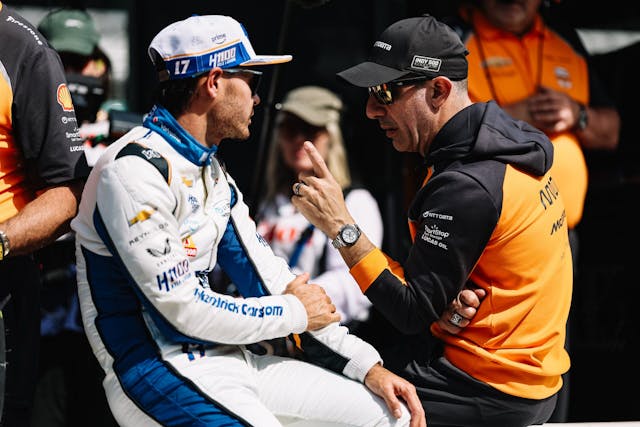Motorsports
2025 Indianapolis 500 Practice Hints at Pace, Storylines Ahead of Qualifying
Just as last year, the focus on the 2025 Indianapolis 500 is not so much on the competition—which should be intense, if this week’s testing is any indication—but on former NASCAR Cup champion Kyle Larson’s quest to do the double: The Indy 500 early in the day, then jet to the NASCAR Coca-Cola 600 at […]

Just as last year, the focus on the 2025 Indianapolis 500 is not so much on the competition—which should be intense, if this week’s testing is any indication—but on former NASCAR Cup champion Kyle Larson’s quest to do the double: The Indy 500 early in the day, then jet to the NASCAR Coca-Cola 600 at Charlotte Motor Speedway to race there.
Sure, it has been done before, but only once has a driver managed to complete all 1100 laps, and that was Tony Stewart’s adventure way back in 2001, when he finished sixth at Indy, third at Charlotte. While Larson wants to win both races, even he would have to admit that completing all the laps would be a victory in itself.
In 2024, weather stepped in as a deciding factor. Indianapolis was rain-delayed, and while Larson ran far better than his 18th-place finish suggests, he was late in heading to Charlotte and missed the start of the race. NASCAR Xfinity driver Justin Allgaier stepped in for Larson, where the plan was to turn the wheel over to him, but the opportunity never came, and Larson never drove a lap in the rain-shortened race.
It was a worst-case scenario for his car owner, Rick Hendrick: While Hendrick, then and now, fully supports Larson’s Memorial Day weekend gamble, not having Larson in the Cup car was deemed unacceptable, and this year, Hendrick has told Larson that he must start the 600, regardless of what happens in Indy. And Larson seems fine with that.

In fact, everything seemed fine for Larson this week, until it didn’t: His practice speeds were solid if unexceptional, and at a press conference on Wednesday, he seemed satisfied with his performance so far.
“Still just trying to get the hang of it,” he said. “I haven’t talked to any of my teammates yet, but I feel like it’s a little different handling-wise this year. I don’t know if that’s the hybrid stuff and the weight of that, but it feels a little different, so not quite the same balance that I had last year. So just got to kind of think through that and how you want to adjust to it, if we want to get it to a point like we were last year.”
Indeed, the other competitors have had a lot of experience with the relatively heavy hybrid system that has added weight mostly to the rear of the car, and that may have been what bit Larson on Thursday, the final day of practice. In the morning session, with Larson making his first attempt to run qualifying speed, his Arrow-McLaren/Hendrick Chevrolet drifted up into the turn 1 wall, careened through the short chute, and hit the turn 2 wall as well. He was fine, but the car suffered moderate damage, and Larson missed the final practice session that afternoon.
“I fought the understeer feeling yesterday and it carried over to today,” he said. “Honestly, though, I’m happy to crash my first IndyCar and live through it.” Larson then departed for Alabama, where he’ll race in the NASCAR Jack Link’s 500 at Talladega Superspeedway.
Larson’s crash wasn’t as severe as the one that occurred shortly afterwards, when two-time Indy 500 winner Takuma Sato wrecked his Rahal Letterman Lanigan Honda, also into the walls of turns 1 and 2. Unlike Larson’s crash, the rear end of Sato’s car came around on him, and the impact damaged the rear and left side of the car. Sato, who had been near the top of the speed charts all week, appeared shaken, but later said he was OK. “I just lost it,” Sato said. “My body is fine.” Like Larson, he did not practice in the second session of the day.
In the combined results of all the practice sessions, the Team Penske Chevrolet of Scott McLaughlin led overall, with a speed of 232.686 mph. Sato was second at 232.565 mph. And third was Team Penske’s Will Power, whose Chevrolet went 232.278 mph. Of the cars that were running “race trim,” as opposed to qualifying trim, the Chip Ganassi Racing Honda of Alex Palou was fastest, at 223.993 mph. That’s the sort of speed we can expect at the front of the field for the actual race.
Logging 265 laps, Kyffin Simpson, in a Ganassi Honda, spent the most time on track, ending up in 10th place. The driver who needs to find the most speed before qualifying is Nolan Siegel, whose Arrow McLaren Honda had a best lap of 222.504 mph, the slowest in the field. Thirty-four drivers participated in Indy practice, all of whom are vying for a spot in the race field of 33. There were also 34 cars in the qualifying field for the 2024 race.
This year, qualifying will be on May 17-18, with the 109th running of the Indianapolis 500 set for Sunday, May 25. The green flag flies at 12:45 p.m.; for Kyle Larson fans, the start of the Coca-Cola 600 is 6:20 p.m.